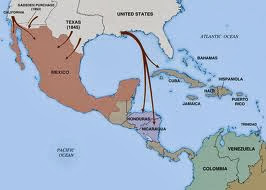Up until a week or so ago, Mexico was the largest country in the world, other than Argentina, with no significant active separatist movement. But that changed on October 30th when the Mexican legislature enacted sweeping tax reforms which have sparked an uprising in the nation’s northwesternmost point, the state of Baja California.
Until the new law, Mexico’s border regions enjoyed a sales tax five percentage points below the national sales-tax rate of 16%. The special tax rate is designed to attract visitors from the United States (who are used to far lower sales taxes) and to dampen border residents’ incentive to pop across the border to shop in U.S. border towns like El Paso, Nogales, and San Diego. The 11% rate applies in areas within 20 kilometers of the United States border, as well as to three resort areas in Sonora state (Puerto Peñasco, Caborca, and Cananea) and to the entire states of Baja California, Baja California Sur, and Quintana Roo. (Quintana Roo is not a border state but feels like one during spring break, when Cancún is filled with drunken U.S. college students.)
This is part of a package which also includes an increase in corporate income tax and capital-gains taxes, which could seriously affect the lucrative maquiladoras, or light-assembly factories, that thrive in the border regions. Tax-hike proponents say the new rate will increase revenue and close loopholes that benefit retailers and manufacturers that are doing just fine anyway. But for many residents of Baja California, it is the last straw. Independence rallies were held over the November 2-3 weekend in Mexicali, the Baja capital, and a new Facebook group called República de Baja California now has over 134,000 likes.
Along with Chihuahua and Nueva León, two other states in the border region, Baja is one of the three most prosperous states in Mexico. But in a country where half the population lives in poverty, that still still means a lot of Bajans for whom any increase in the sales tax is a hardship. However, proponents of Baja independence feel it is about more than taxes, even if maquiladora owners and chambers of commerce are the loudest complainers about the tax hike. As one journalist in the region put it, “There’s this longstanding feeling on the Northern border—‘Look, we’re a different region. We’re right next to California ... we have to compete day after day with the United States. We offer hope to a lot of Mexico and we’re also an escape valve for people in poorer regions of Mexico who come here to find work and hope for the future.”
But Baja has been here before, in very different circumstances. In the 1850s, a Tennessee-born soldier of fortune named William Walker declared what are now the states of Baja California and Baja California Sur (which make up the current proposed republic too) an independent República de Baja California and declared himself president. This kind of off-the-cuff state formation by non-state actors was part of a messy geopolitical process going on in the U.S.–Mexico border regions called “filibustering” (no relation to the modern meaning of filibustering; no diapers or catheters or recitations of The Song of Hiawatha are involved). 19th-century filibustering meant the takeover of border areas by mercenaries, who settled Anglos (English-speaking whites) in the area, erected state structures, and then ushered the territories toward U.S. statehood. Similar projects included the brief-lived Republic of the Rio Grande, with a capital in Laredo, and the Republic of Yucatan. One could certainly classify the processes by which California and Texas became independent, and then parts of the U.S., as successful filibusters.
But Walker’s Republic of Baja California, with its capital in Ensenada, was not authorized, nor even approved of, by Washington, and this is partly because of its relationship to internal U.S. politics. In the 1850s, slavery was the divisive issue that was sending the U.S. hurtling in the direction of civil war. The loss of Kansas to the “free state” side meant that Southern slave states were desperate to preserve the balance of power between slave and free states and were eyeing tropical regions as a place to found new slave states. An organization called the Knights of the Golden Circle—of which John Wilkes Booth and Sam Houston were reputed members—sought to establish Southern-Anglo-ruled slave territories all around the Gulf of Mexico and Caribbean, extending to Yucatan, Cuba, and even as far as the Guyanas (the Caribbean rim being the “Golden Circle”). Walker’s agenda was similar, and after declaring Baja independent he briefly tried to convince Louisiana, a slave state where he had wealthy sponsors, to annex the Baja peninsula.
 |
| William Walker’s travels |
 |
| Flag of the 19th century’s brief-lived Republic of Sonora |
 |
| Walker is remembered fondly in Tennessee, if nowhere else |
If so, I have some suggestions. Understandably, modern Bajans do not want to use the smart-looking flag used by William Walker ...
... but instead of using the relatively drab, bureaucratic-looking flag the movement has been using so far (which unapologetically borrows Walker’s color scheme), ...
... or the far worse current Baja California state flag, which is merely its seal ...
... which brings to mind nothing so much as the Wonder Twins from the old Saturday-morning cartoon series Super Friends ...
... they should really consider adopting the flag of Baja California Sur as their national flag:
[Also, for those who are wondering, yes, this blog is tied in with a forthcoming book, a sort of encyclopedic atlas to be published by Auslander and Fox under the title Let’s Split! A Complete Guide to Separatist Movements, Independence Struggles, Breakaway Republics, Rebel Provinces, Pseudostates, Puppet States, Tribal Fiefdoms, Micronations, and Do-It-Yourself Countries, from Chiapas to Chechnya and Tibet to Texas. Look for it some time in 2014. I will be keeping readers posted of further publication news.]











No comments:
Post a Comment